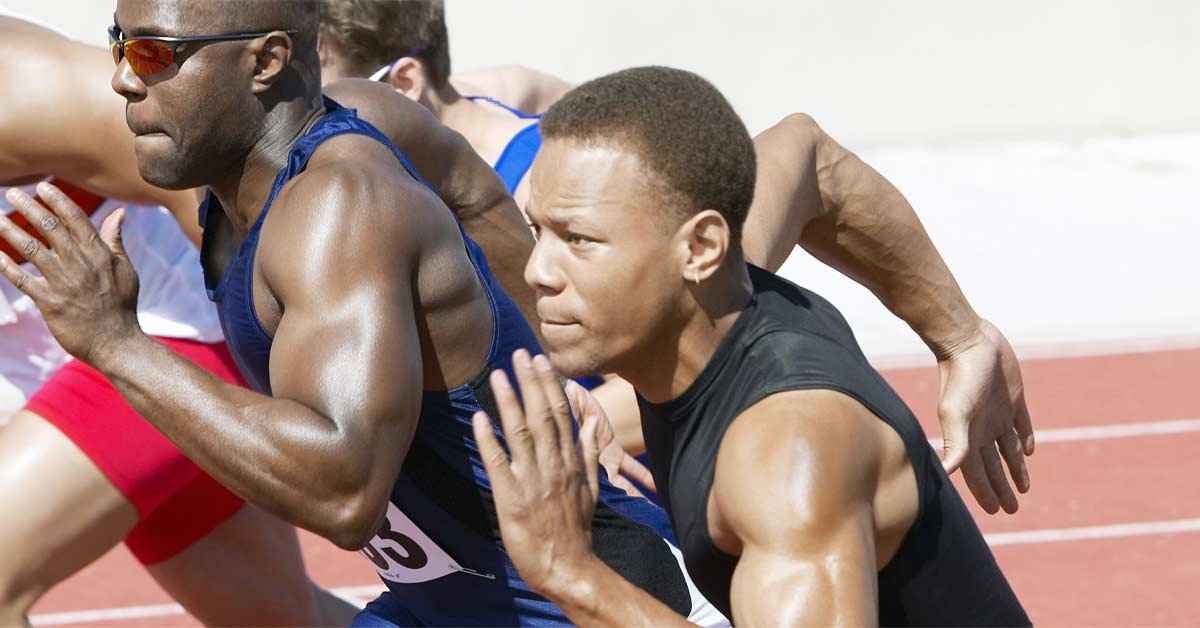
Elite and professional athletes enter every workout with purpose and an unrelenting resolve to increase preparedness and their resultant performance. Athlete monitoring has become essential in high-performance development to ensure the training plan targets the desired physiological adaptive responses that will culminate in competitive readiness. With this in mind, near infrared spectroscopy (NIRS) devices allow the visualization and quantification of physiological and biomechanical responses to exercise by offering real-time feedback on muscle activation, physiological distress, state of recovery, and overall fitness levels.
Using muscle oxygenation as an athlete-monitoring tool can benefit your day-to-day training and provide insight on chronic adaptations. Share on XUsing muscle oxygenation as an athlete-monitoring tool can benefit your day-to-day training and provide insight on chronic adaptations. These devices are most often utilized by endurance athletes to monitor steady state or repeated bouts of exercise. However, considerable evidence has provided a case for the use of muscle oximetry within the strength and power realm.
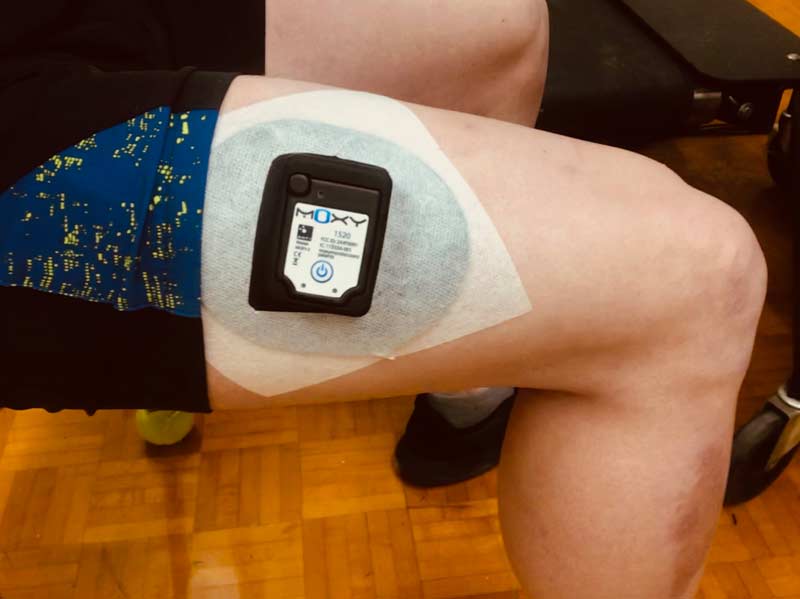
What Is Muscle Oxygenation?
Muscle oxygenation is a representation of the amount of oxygenated hemoglobin compared to total hemoglobin within the muscle. Simply put, as work intensifies, muscle oxygenation decreases, and as exercise intensity decreases, muscle oxygenation increases. The beauty of being able to monitor muscle oxygenation lies in the more-complex physiologic implications that ensue when repeated bouts of guided training are performed. For more insight, check out these articles on muscle oxygenation and NIRS devices.
What you should be tracking:
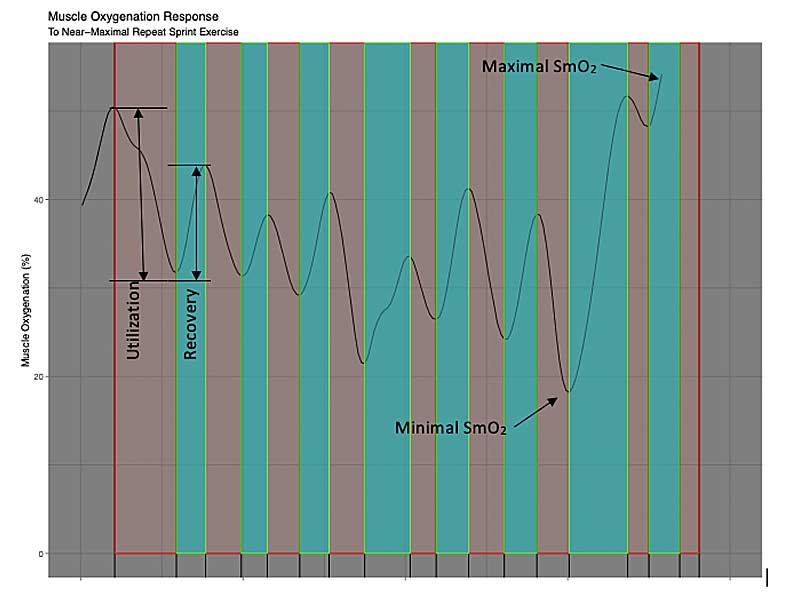
Maximal Oxygenation: Once you begin to use muscle oxygenation as a tool for training and monitoring, you’ll notice that after warm-ups or intense bouts, muscle oxygenation exceeds baseline values. This is an athlete’s physiology super-compensating for the previous workload. Better-trained individuals are capable of achieving higher maximal oxygenation as part of their enhanced muscle metaboreflex, and the body’s ability to react and reestablish an exercising homeostasis.
Minimal Oxygenation: The ability to use the oxygen in the muscle. Even though oxygen may be present, it does not necessarily mean the muscle is capable of using it. Just like a car running efficiently, a person may have the ability to produce more energy if they are able to utilize all parts effectively. Strength and power athletes tend to neglect the importance of their aerobic health; however, recovery is an aerobic process. Neglecting to enhance aerobic metabolism is no different than disregarding that eighth play in the third quarter.
Neglecting to enhance aerobic metabolism is no different than disregarding that eighth play in the third quarter. Share on XOxygenation Utilization and Recovery: The metrics of intensity. Once you establish an athlete’s minimal and maximal values, you can begin to prescribe workouts based on the specific adaptations to enhance athletic performance.
Rates of Reoxygenation: After an intense bout of training, this variable speaks to how quickly oxygen levels return to baseline. Rates of reoxygenation have been linked with improved recovery of power output and phosphocreatine (PCr).1
Normalization: Training status creates variation in maximal and minimal deoxygenation levels. I find it helpful to normalize values during data analysis. It is important to note the raw maximum and minimum values as an indication of training status. If a trained and untrained person both deoxygenated 20%, this could have very different implications. A trained person may reduce from 80% to 60%, while a less-trained person could reduce from 60% to 40%. Not only may the ceilings of each athlete be different, but so may the floors. If the trained athlete’s minimum is 10% and the untrained athlete’s is 20%, there is a massive difference in the amount of oxygenation reserve.
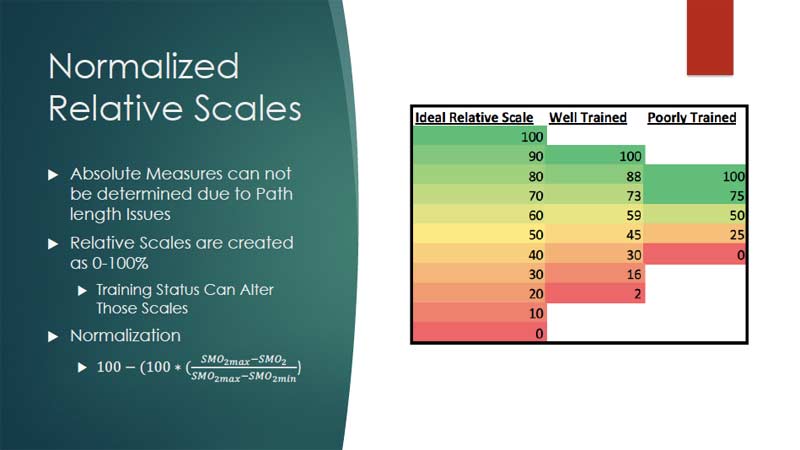
Traits of Team, Strength, and Power Sports
Field and court sports require a spectrum of performance characteristics to succeed, though the crucial moments of every sport occur during bouts of high-intensity efforts, which are often repeated in rapid succession.2,3Team sports require a minimal threshold of endurance to be able to compete for a game’s duration, so training should be focused on increasing an athlete’s ability to complete repeated bursts of high-intensity efforts.
Typically, these traits are developed with extensive, exhausting sprint sessions that achieve the physiological distress needed for adaptation signaling. However, these sessions often tend to be excessively exhausting, leading to chronic fatigue management issues. In the paradigm of periodization, training should transition from general to sport-specific characteristics with decreasing volumes throughout the training cycle.4In these crucial time frames, programming must be executed with surgical precision to ensure enough stress has been administered to maintain and/or promote adaptation without leaving the athlete unable to perform in the game later in the week.
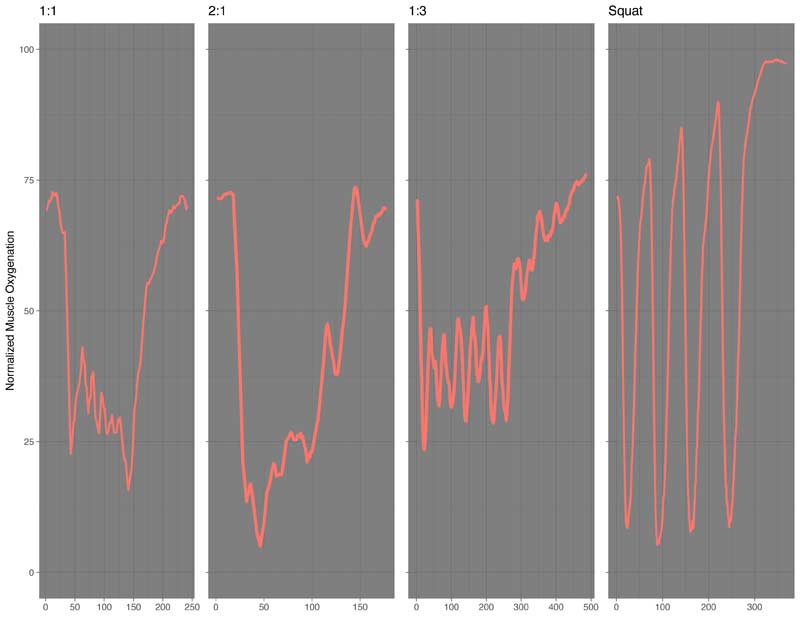
Repeated and Intermittent Sprint Training with Muscle Oxygenation
Repeated sprint ability (RSA) is a fundamental component of field and court sports that is best executed with high levels of repeated force production and is true in other forms.3Carl Valle discusses RSA to a great extent here. Limiting factors of repeated sprint ability include neuromuscular fatigue, energy production limitations, and metabolic by-product accumulation.3
Energy Production Limitations: PCr-ATP – High Quality and Power
The Phosphocreatine-ATP pathway supplies a massive burst of energy during the first 6-10 seconds of high-intensity activity. The rate at which this energy is released allows for rapid rates of muscular contractions, creating peak power outputs. You may be asking yourself why muscle oxygenation is important to an energy production mechanism that operates independently of oxygen. The answer is in the ability to set the stage for the next burst of high-intensity effort.
While using muscle oxygenation to guide high-intensity short-duration sprint work, you can assess, compare, and direct other training parameters to improve muscle oxygenation recovery. Share on XPCr resynthesis is completely dependent upon oxygen availability.5,6McCully et al. demonstrated that, with the assumption of blood pH as not acidic, PCr and muscle oxygenation recovery are similar. In a practical setting, you may use muscle oxygenation returning to a baseline value after an intense sprint as an indication of PCr replenishment.1Following this guideline will create work-to-rest ratios smaller than typically thought for RSA training; however, it allows for extremely high-quality sprint repetitions in which technical and tactical aspects of the movement can be addressed. While using muscle oxygenation to guide high-intensity short-duration sprint work, you can assess, compare, and direct other training parameters to improve muscle oxygenation recovery.
Anaerobic Glycolysis and Buffering Capacities: Repetitive Power
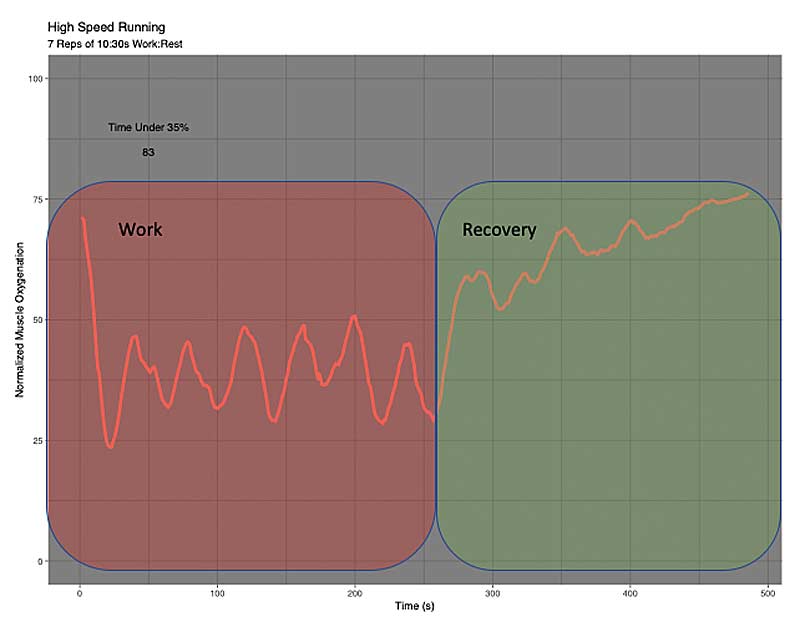
Every athlete has been put through the wringer at some point in their athletic career. In team settings, athletes often dread hearing the words “on the line” or “on the boards,” as that usually means a storm of metabolic acidosis will soon erupt. What is more interesting is that while coaches are directing a storm of metabolic disturbances, they are often conducting a “survival of the fittest” test.
Every team has three classes of athletes: A) those who complete every repetition of the repeat sprint session with good form and stature; B) those who start off looking strong but rapidly decay; and C) those who seem hopeless. The true purpose of these types of workouts may be up for debate, but let’s assume that their primary purpose is to instill metabolic disturbances, and thus adaptations and performance enhancement.
Athlete A may enter each of these sessions very aware that they can coast at a minimal effort and still look good. With good theatrics, they may even sell the fact that they look tired. Athlete B will likely show a trend in oxygenation kinetics that seems to be beneficial, but during the last several repetitions develop substantial fatigue that may become a chronic issue interfering with progression. Athlete C likely needs to build a better base consisting of sprint kinematics and low- to mid-intensity exercise endurance.
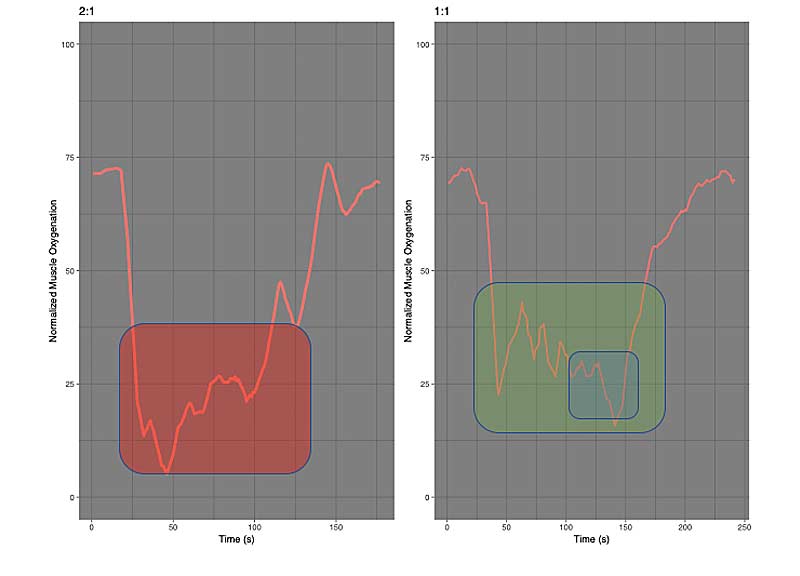
Muscle oxygenation is a new variable and, as coaches, we want to use new technology to boost our training sessions. However, when we see confusing numbers, we are quick to dismiss the use of the tool. We need to review the evidence and rewrite the curriculum base utilizing technological advancements.
The above-mentioned practice scenario is commonly used to “get our athletes stronger.” Coaches commonly think of those workouts as building sprint endurance, but evidence suggests otherwise. This can lead to an in-depth conversation about the training principle of specificity and its true meanings. However, we will keep the review short.
Repeated sprint efforts in a competition scenario are comprised of several highly intense efforts followed by a rest interval that’s typically due to a substitution or to the location of play changing. On average, an ice hockey shift lasts for approximately 45-60 seconds of near-maximal exertion skating. As a coach, you can use NIRS devices to analyze patterns of oxygenation kinematics, identify muscle oxygenation profiles in response to competition scenarios, and program to match the specific demand. Evidence shows that there are two trends in improving glycolytic energy production and buffering capacity that differ tremendously.
Greater glycolytic metabolism tends to lead to greater initial sprint performances, though they are also coupled with a greater fatigue index.7If your athlete is strong at maintaining their efforts, but struggles to make it to the play first, an increased glycolytic capability may be a high priority. Increasing glycolytic energy production while promoting or maintaining other important characteristics, such as rates of force development and technical proficiency, requires extensive activation of glycolytic muscle fibers paired with adequate rest to maintain force-producing characteristics.8
If your athlete is strong at maintaining their efforts, but struggles to make it to the play first, an increased glycolytic capability may be a high priority. Share on XWhen your athlete performs repeated sprints—maybe 10 repetitions of 15 seconds with 15 seconds of rest—you will notice that a delay in muscle reoxygenation will develop, accompanied by decaying maximal oxygenations between sprints, as seen in Figure 3- 1:1. This represents two main concepts: 1) the Bohr effect and 2) an increased reliance on oxygen to produce force. If, in this scenario, your athlete’s oxygenation response resembles Figure 3-2:1, you should make an alteration in intensity either through speed or rest intervals.
- The Bohr effect is a physiological phenomenon in which increased acidity and carbon dioxide reduce the hemoglobin’s affinity for oxygen. This principle allows us to interpret muscle oxygenation responses; in particular, rates of muscle reoxygenation and the number of repetitions until a plateau in oxygenation occurs (Figure 5-1:1, blue box). When working with your athletes and monitoring their sprint workouts with muscle oxygenation, you can qualitatively guide a training session by observing sprint to sprint oxygenation patterns. Chronically, you should calculate rates of reoxygenation or assess the shape factor and how many maximal exertion repetitions to complete until a plateau is observed.
- The increased and consistent reliance on oxygen, which is represented by a plateau of oxygenation, displays a continued Bohr effect—but also a greater reliance on type 1 (aerobic) muscle fibers. When an athlete continues to rely on type 1 muscle fibers, it blunts the amount of glycolytic activation and dramatically decreases the amount of power produced, leading to slow athletes training to be better at being slow. If you are leading a session and one athlete begins to display a plateaued muscle oxygenation accompanied by delayed rates of reoxygenation, it would be best to allow that athlete to recover and begin a new set once muscle oxygenation has gone through a super-compensating recovery and established a resting baseline. Incorporating real-time monitoring allows a coach to confirm their programming tactics or allows them to make educated adjustments that are objective and easy to explain to their athletes.
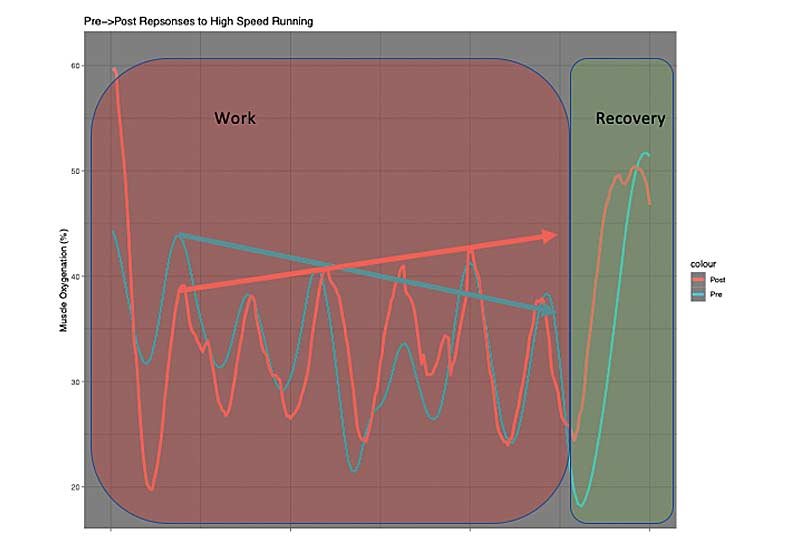
We have discussed monitoring and directing training for maximal power production with the PCr-ATP system and multiple high-power exertions with the glycolytic energy system, and we will move on to prolonging your athlete’s ability to continually repeat high-power exertions. Increased acidity resulting from high levels of glycolysis has been found to impair repetitive high-power exertions. In an attempt to prolong the time course of performance decay, athletes and coaches target mechanisms to increase the blood’s buffering capacity. An increased buffering capacity allows for a great accumulation of acidic by-products without altering blood pH to a great extent.9
Typically, routines that target increasing muscle-buffering capacity include a multitude of time intervals and intensity levels surrounding and exceeding VO2 maximum. Little is known about time interval optimization for interval training targeting high-intensity endurance, though some researchers have shown notable improvements using percentages of the maximal sustainable time running at VO2 max.10Work intervals can be established by simulating game work-to-rest intervals, or by creating work-to-rest ratios that allow for rapid, substantial muscle deoxygenation with incomplete reoxygenation.10
As metabolic acidosis builds and muscle reoxygenation rates decline, maximal reoxygenation will decrease from sprint to sprint. If the athlete performs too high of an intensity, they may not be capable of finishing the prescribed work-set and may present a response similar to Figure 5-2:1. This athlete’s training needs an intensity alteration of either speed- or work-to rest ratio. If the athlete does not display a regressive reoxygenation rate and/or further minimal muscle deoxygenation in response to the sprints, the athlete may need to increase the intensity.
The Two-for-One Deal: Strength Training
Strength training is widely accepted as being beneficial for athletic performance, but the rationales and ideologies of optimal training strategies are strongly debated. A common theme that exists, or at least should exist, is that different variables are emphasized throughout a training cycle depending upon which traits they desire to train. In the paradigm of block periodization utilizing phase potentiation, fitness phases are planned along a timeline to allow for the emphasis of concentrated loads. This planning method is all-encompassing and considers sport-specific and resistance training and all the variables that influence the process. By understanding the physiological implications of training and the stimuli required to elicit certain adaptations you can create a platform to synergistically integrate your resistance training program with your sport-specific training.
Muscle oxygenation kinetics have not been thoroughly researched in resistance training for the athletic population, but the groundwork that exists allows for a short conversation about specificity and long-term fatigue management.11Training, in general, is extremely taxing on the body and you must incorporate planned recovery time into your training plan.
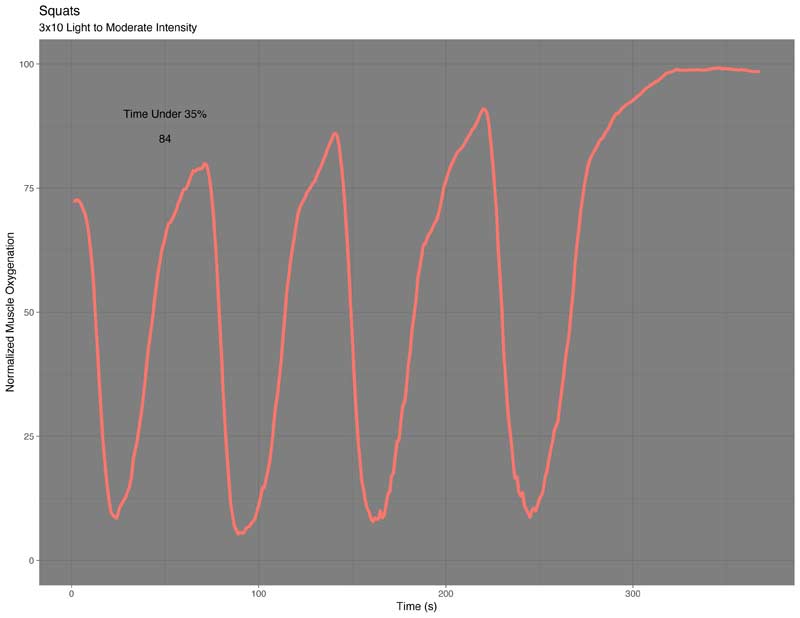
Muscle oximetry has been available to the consumer market for over 10 years, though it has been slow to gain popularity in the sports performance field due to cost and a lack of supporting literature allowing for ease of integration. With a small bit of physiological awareness and coaching creativity, you can apply muscle oxygenation to your training paradigm to add precision and reduce unnecessary fatigue in your athletes. Strength training has been found to produce similar metabolic and oxygenation disturbances as high-intensity skating and sprinting.12
During a general preparation phase or a period in which you are looking to remove the impactful stress of running, you may be able to maintain or improve the physiological mechanisms that potentiate sprint training later in the cycle. General preparation phases including higher volume work at lighter intensities related to 1RM are utilized. Those workloads reduce muscle oxygenation with an accompanied slow rate of recovery similar to the example provided for increasing muscle buffering capacity. Hoffman et al. demonstrated a 44.1% longer day to initiate reoxygenation when performing sets of 15 repetitions at 60% 1RM as compared to sets of four repetitions at 90% of 1RM, accompanied by slightly greater lactate concentration 20 and 40 minutes post exercise.12
As previously discussed, to preserve the skill and technique of more intense runs to improve glycolytic energy production, a greater amount of rest is recommended. When targeting absolute or maximal strength, you may follow the same concept in an attempt to prevent excessive acute metabolic stress from impairing your ability to produce force rapidly.
Muscle oxygenation monitoring can be applied during individual sessions or chronically. Variables such as minimal oxygenation, maximal oxygenation, oxygen utilization, recovery, and their prospective rates provide insight on exercise intensity and athlete training status. Near infrared spectroscopy could provide an individualized method to fine-tune and optimize training.
References
1. McCully, K.K., Lotti, S., Kendrick, K., Wang, Z., Posner, J.D., Leigh, J., et al. “Simultaneous in vivo measurements of HbO2 saturation and PCr kinetics after exercise in normal humans.” Journal of Applied Physiology. 1994;77(1):5-10.
2. Ben Abdelkrim, N., El Fazaa, S., and El Ati, J. “Time-motion analysis and physiological data of elite under-19-year-old basketball players during competition.” British Journal of Sports Medicine. 2007;41(2):69-75.
3. Girard, O.R., Mendez-Villaneuva A., and Bishop, D.J. “Repeated-sprint ability – part I: factors contributing to fatigue.” Sports Medicine. 2011;41(4):673-94.
4. DeWeese, B.H., Hornsby, G., Stone, M., and Stone, M.H. “The training process: Planning for strength-power training in track and field. Part 1: Theoretical aspects.” Journal of Sport and Health Science. 2015;4(4):308-17.
5. Harris, R., Edwards, R., Hultman, E. Nordesjö, L., Nylind, B., and Sahlin, K. “The time course of phosphorylcreatine resynthesis during recovery of the quadriceps muscle in man.” Pflügers Archiv: European Journal of Physiology. 1976;267(2):137-42.
6. Kime, R., Katsumura, T., Hamaoka, T. Osada, T., Sako, T., Murakami, M., et al. “Muscle reoxygenation after isometric exercise at various intensities in relation to muscle oxidative capacity.” Oxygen Transport to Tissue XXIV: Springer; 2003. p. 497-507.
7. Gaitanos, G.C., Williams, C., Boobis, L.H., and Brooks, S. “Human muscle metabolism during intermittent maximal exercise.” Journal of Applied Physiology. 1993;75(2):712-19.
8. Smith, K.J. and Billaut, F. “Influence of cerebral and muscle oxygenation on repeated-sprint ability.” European Journal of Applied Physiology. 2010;109(5):989-99.
9. Bishop, D., Edge, J., Thomas, C., and Mercier, J. “Effects of high-intensity training on muscle lactate transporters and postexercise recovery of muscle lactate and hydrogen ions in women.” (Author abstract) (Clinical report). The American Journal of Physiology. 2008;295(6):R1991.
10. Laursen, P.B. and Jenkins, D.G. “The scientific basis for high-intensity interval training: optimizing training programmes and maximising performance in highly trained endurance athletes.” Sports Medicine(Auckland, NZ). 2002;32(1):53-73.
11. Pereira, M.I.R., Gomes, P.S.C., and Bhambhani, Y.N. “A brief review of the use of near infrared spectroscopy with particular interest in resistance exercise.” Sports Medicine. 2007;37(7):615.
12. Hoffman, J.R., Im, J., Rundell, K.W., Kang, J., Nioka, S., Speiring, B.A., Kime, R., and Chance, B. “Effect of muscle oxygenation during resistance exercise on anabolic hormone response.” Medicine & Science in Sports & Exercise. 2003;35(11):1929-34.




